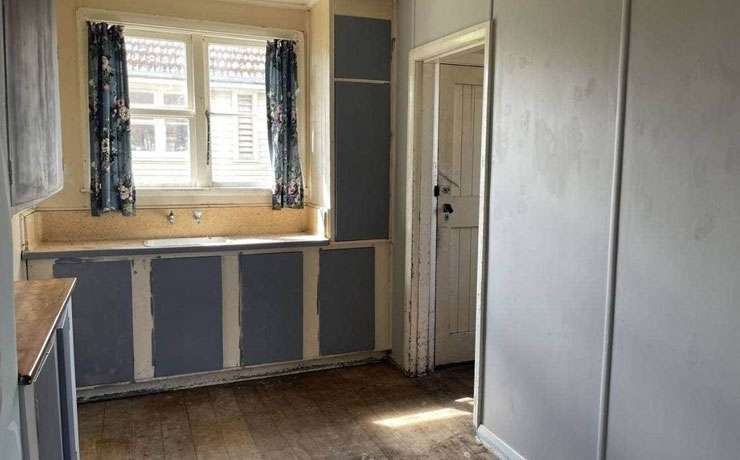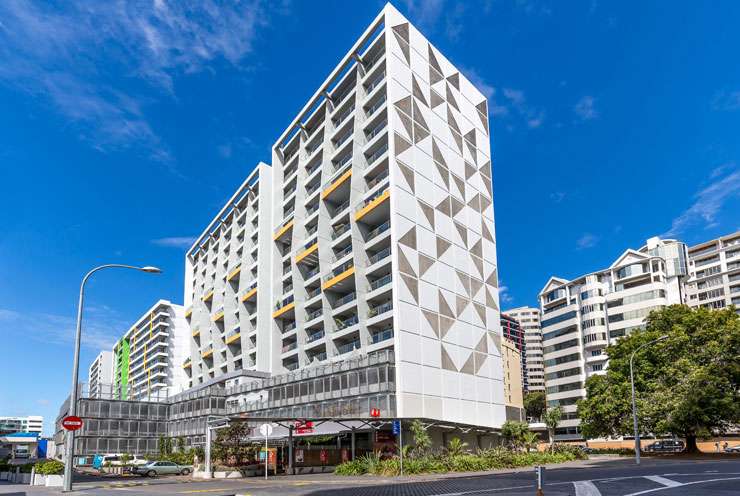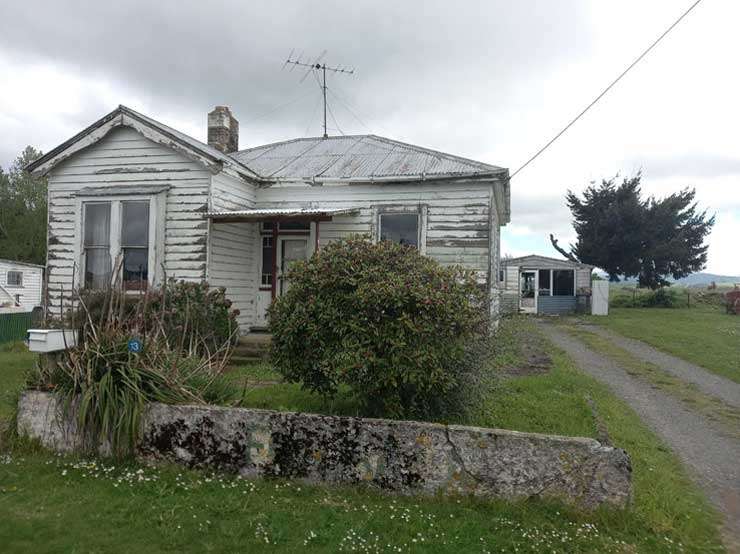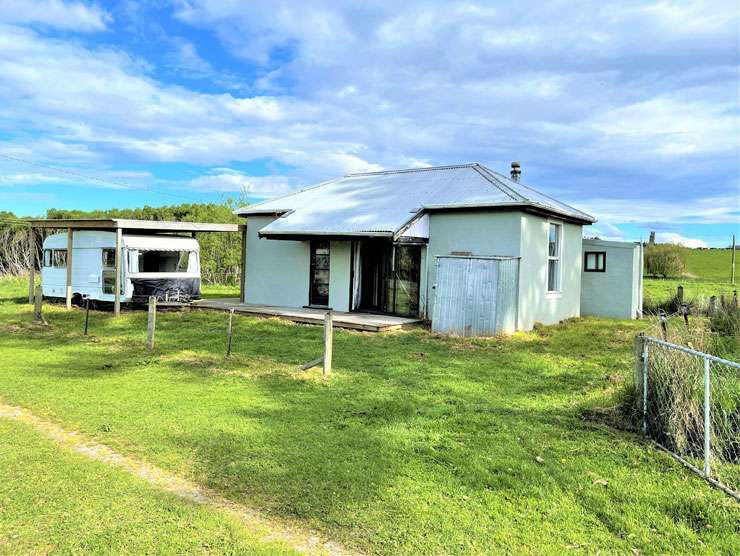Homes with a twist can still be snapped up for less than $100,000. OneRoof went searching for New Zealand’s bargain basement homes. They exist, and all come with a unique story, albeit, not always good.
At best buyers need to roll their sleeves up and do a mind boggling amount of renovation. Many of the lowest price homes in the country come with all sorts of risks written all over them.
Almost all homes priced at less than $100,000 are in two parts of the country. Either in the deep south, or smack bang in the middle of the country’s most expensive city Auckland. OneRoof did find one in Taranaki.
The cheapest home in Taranaki
Start your property search
Harcourts Hawera agent Lisa Ratahi made headlines last month when she listed Wilson Street, Waverley for offers over $89,000. The two bedroom 1940s weatherboard home on 665m2 of land had fallen into disrepair.
Ratahi’s remit was to get it sold. “Years and years ago [the owner] purchased it for her children. Over time it became a rental. Because she was older the maintenance wasn’t getting done and it had probably not been lived in for over a year.”
When the property hit the market, Ratahi was inundated with phone calls. “We had 25 unconditional offers and we were asked to send the top 12 through to the vendor’s solicitor.” At least another 25 wanted to make conditional offers.
“I had to prequalify people otherwise it could really have got out of hand. I had people emailing saying: ‘I’ll give you $60,000’. Even the asking price of $89,000 was never going to buy it.” The house eventually sold for more than $100,000.

In need of attention: Inside the Wilson Street home. Photo / Supplied
Homes at the bottom end of Taranaki’s housing market are usually bought by investors who fix them up to a rentable state, says Ratahi. “The rents are pretty high in our area. This is maybe one of the highest yields in the country.”
Sometimes out-of-towners buy properties such as the Waverly one as holiday homes. “Waverly is close to beaches and quite a cool place to have as a holiday home and to get out of the city,” says Ratahi.
Sadly, first home buyers would have struggled to get a mortgage on the property. “What I said to them was it wouldn’t possibly pass for insurance. If they’d spoken to the bank, [the bank] would have said, ‘Well, hang on, does it comply with X, Y and Z?.’ But it wouldn’t have. You’re not going to get a mortgage if you can’t get insurance.”
Ratahi estimated that once done up to a liveable state, the property would reach between $300 to $350 per week rent. “You could do it up for 100 grand easily. You’d probably get $300,000 for it if it’s done up to a (liveable) level.”
A $1m home for $35,000
Auckland-based City Sales agent Scott Dunn sees a steady trickle of sub $100,000 properties for sale through his agency. They are either leakers or leasehold, or both.
At the time of writing Dunn’s colleague James Mairs had a leasehold apartment for sale in the Scene One apartment building.

A leasehold apartment on Beach Road, in central Auckland, is for sale. Photo / Supplied
The beautiful 61sqm flat at 1301/2 Beach Road, Auckland, has two bedrooms, walk-in wardrobe, bathroom, carpark, onsite gym and swimming pool. As well as being leasehold, it has an unusual ownership structure instead of a body corporate.
The block sits on Ngāti Whātua Ōrākei Whai Rawa land, which is subleased to a third party. The ownership structure makes it extremely difficult to do building repairs, says Dunn.
Banks are also reluctant to lend money for leasehold purchases.
Asked how much the apartment would fetch if it was freehold, Dunn said: “Definitely over a million. It beautiful. It’s right on the waterfront. It’s literally above some of Auckland’s’ most fabulous restaurants.
“We [often] sell them to people who already own in the building or we sell to incredibly wealthy people who want a fabulous space right there. They could buy that on a credit card, and then deal with the outgoings later,” he says.
Dunn says that most sub-$100,000 apartments that come up for sale in Auckland are almost always leaky. Many are leaky and leasehold, but they can still hold appeal for investors.
“We literally have people that call us up and say, ‘What do you have that’s leaky?’ The buyers know the apartments they are buying could cost $200,000 to $400,000 to remediate but expect to make a good capital gain when the work is done. They are speculating that in the five or six years that it takes to fix, property prices will grow and they'll be left with a $900,000 freehold apartment.”
Resplendent with a sprung dance floor
House prices have leapt so high in recent years that many agents selling bottom end properties are inundated with enquiries. That was the case for Ray White Balclutha agent Bryan Hayden when he listed an old district hall at 298 Kaitangata Highway, Stirling, for $78,000.
The 160sqm hall, which was built around 1910 and has been empty for around 20 years, has a sprung dance floor and requires a significant amount of work to bring it back to life. In addition, the hall has no land either side, only a small patch at the rear where it backs onto the Clutha River.
“I have had enquiries from all over the country,” says Hayden. “Particularly a lot of North Island people because it’s cheap. I’ve had people who want to [turn] it into an art centre. All different types. They get excited.”

An old district hall at 298 Kaitangata Highway, in Stirling, is on the market for $78,000. Photo / Supplied
At the time of writing a deal was about to be signed with an Otago-born returnee . “His plans are to live in it,” says Hayden.
Like many other agents in Otago and Southland, Hayden had no difficulty selling bargain basement properties in the past couple of years. But they’re not for faint hearted buyers .
Town sewage a bonus
Todd & Co Realty agent Melanie Muldrew says homes at the bottom end of the market in Southland are growing in popularity.
Muldrew recently sold a “roll up your sleeves” do-up in Ohai that had been listed seeking offers over $75,000. The three-bedroom 100sqm 1920s house sits on a 1012sqm section on Milton Street and is 76km from Invercargill and 160km from Queenstown.
Speaking to OneRoof before the sale was done, Muldrew said: “I’m not quite brave enough to advertise it as a holiday house in Queenstown. but if you leave really early in the morning you could go to Queenstown, ski, and drive back. Maybe you have to have your own aeroplane.”

A do-up in Ohai, 160km from Queenstown, recently sold. Photo / Supplied
The property once housed squatters and although dilapidated, had some advantages. It is connected to town water and sewage. Septic tanks in particular can be costly to maintain.
Muldrew said she had received multiple offers on the property. “[Multi-offers] are something that would never have happened two years ago We had a lot of property in Ohai that was in better condition than this two to three years ago and it would be on the market for months.”
Muldrew put the newfound interest in Southland down to other parts of New Zealand being out of reach for buyers financially. “If you’re from Auckland or Wellington or any city in New Zealand and you are able to get a section this size with views, even if you have a crooked old house on it, it’s still like ‘golly, what a deal’. People are looking at the cheaper areas of New Zealand, and western Southland probably is the cheapest.”
Muldrew says the buyers are generally hands-on people who do the work themselves. “You have a shortage of builders (in Southland), and it costs a lot of money to get someone in to do the work.”
Fishing hut/family crib
One Balclutha district property with a twist is a fishing hut/family crib at 1446A Clydevale Road, which is seeking offers above $69,000. The inside of the little crib beside the Pomahaka River has already been renovated in pure Kiwiana style and comes with a static caravan as an extra bedroom.
It’s the third such crib One Agency real estate agent Katrina Garside has listed in recent years. Buyers are only buying the crib and caravan. The land beneath them is a roadside reserve.

A fishing hut for sale on Clydevale Road in Balclutha. Photo / Supplied
At some point in history, says Garside, five such fishing huts were built on the reserve and the arrangement accepted by the local council. They have an informal lease with the council, but pay only rates, not ground rent, she says.
“Nothing Is permitted. You won’t’ get insurance. If they ever decided to move the road you would have to move the hut. But there is nothing (planned) in the foreseen future.”
On the upside, says Garside: “It’s a perfect little spot and you have the privilege of going and staying there. There is a lot of risk involved with it, but you’re the only ones allowed to hang out there.”
Buying below $100,000: What you need to know
Other issues not already mentioned that buyers may face with bottom end homes include:
• Is it liveable? If you can move in and live while doing it up, you’ll save money on rent. It may not be safe if it needs rewiring or other work done.
• Some building materials could cause problems such as asbestos and Weatherside. The latter is looks like Hardiplank but is made from wood fibres glued together. When water penetrates it swells, takes on the consistency of Weetbix and start to rot.
• Methamphetamine contamination. If a home has been used for the manufacture of methamphetamine it can cost tens of thousands of dollars to make healthy again.
• Squatters. Most squatters can be removed, but sometimes buyers find themselves facing lengthy legal proceedings if the squatters or former tenants won’t leave.
• Leaky homes. A truly leaky home built between 1988 and 2004, may need to be demolished. The rot can be in the structure of the home and the resulting mould can make residents very ill.
• Council consents. Buyers seeking to convert old commercial property to residential do need to ensure that the council will allow the work to take place.
• Not allowed to live there. Very occasionally properties come with licences to occupy or leases that prevent owners living onsite permanently.




















































































